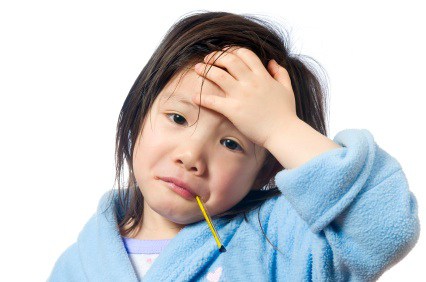We’ve all been there. It’s 2 am, and supernatural mama-senses jolt you awake. A bit confused by the rude awakening, you hear the faint cry of your little one in the other room. Groggily, you make your way across the house. Dodging the legos, dog toys, and that chair that your husband forgot to push back in. You reach your child. One touch of the forehead reveals the inevitable: another childhood illness has come for a visit. Shoot. Do I have any Tylenol left? I really should have purchased two of those bottles since they were on sale. Oh, man. What if this is the flu?? Where did I put that extra trash can…?
Stocking your medicine cabinet properly can help ward off added stress when illness strikes, a toe is stubbed, or your youngest decorates his fort using poison ivy. So allow me, a friendly neighborhood nurse, to help you create one for whatever ails ya!
MEDICATIONS
Be sure to consult your child’s healthcare practitioner for proper dosage instructions on any medication. Generic names listed below with examples of a brand name in parentheses.
Acetaminophen (Tylenol): Can be given every 4-6 hours for acute pain and fever. Does not decrease inflammation (swelling).
Ibuprofen (Motrin): Can be given to children 6 months and older every 6-8 hours for pain, inflammation, and fever. Tends to have better pain control for dental/teething pain.
Antibacterial Ointments: Apply to cuts and scrapes after thoroughly cleansing with mild soap and water to prevent infection.
Diaper rash cream: Use a product containing zinc oxide such as A&D Ointment, Triple Paste, Desitin.
*The BEST thing I have found to treat severe diaper rashes? Cornstarch! Sprinkle liberally on a clean bottom. Cover with a thick paste. (I prefer Triple Paste). The cornstarch decreases redness and irritation. The paste acts as a barrier. Do NOT wipe off in between diaper changes. Keep applying paste as necessary to keep that barrier. Cleanse skin gently, and repeat steps once a day. I learned this from a dermatologist when I worked in the ICU. It works!
Saline Nasal Spray: To aid in clearing stuffy noses.
Saline Eye Drops: Used for itchy or dry eyes.
Simethicone drops (Mylicon): For gas pain/bloating.
Diphenhydramine (Benadryl): Can be used to relieve allergy symptoms such as itchy, watery eyes and sneezing as well as soothing an itchy bug bite. Warning: this product generally causes drowsiness. However, some kids experience the opposite reaction!
Hydrocortisone cream: Itch relief for rashes, skin irritation, and bug bites.
Hydrogen Peroxide: A no-sting solution for disinfecting those inevitable minor cuts and scrapes. This is also excellent at removing blood stains!
Petroleum Ointment (Aquaphor or Vaseline): SO many uses! Chapped skin, minor burns, abrasions, eczema, lubricating a rectal thermometer, etc.
Calamine Lotion: For itching and skin irritation (chicken pox, poison ivy/oak/sumac, etc.)
Oral Electrolyte Solution (Pedialyte, Infalyte): For rehydration secondary to frequent diarrhea and/or vomiting. Do not use Gatorade/Powerade as these contain too much sugar and can worsen symptoms. Small sips every 15 minutes is a good starting place for rehydration.
MISCELLANEOUS ITEMS
Adhesive tape
Adhesive Bandages (Band-Aids): Purchase a variety of sizes.
Liquid Bandage (New-Skin): Great for flexible places or creases on which bandages won’t stay.
Cotton balls and swabs
Gauze pads in a variety of sizes
Dosage cups and syringes: Insider tip: Ask your pharmacist for a few extras to keep on hand. Can wash thoroughly and reuse.
Disinfectant and/or alcohol wipes: I like to keep a few alcohol wipes in my purse! But I’m a nurse, and I’m weird in that way.
Insect Repellant: Safe for children 2 months and older. Click here for more info about insect repellent safety.
Nasal Aspirator Bulb or NoseFrida: I know some of you may think the NoseFrida is 1,000% disgusting, but I’m telling you…it changed my life! Don’t knock it ’til you try it!
Antibacterial soap
Sunscreen: Use broad-spectrum with at least SPF 15 per the American Academy of Pediatrics. Not for use on infants less than 6 months of age.
Thermometer: Rectal temps are recommended for children less than 3 years old. A thermometer under the arm is appropriate for those children who won’t sit still for a rectal reading. Ear thermometers are discouraged due to inaccuracy.
Tweezers: Perfect for removing splinters and ticks. Sterilize between uses.
Nail clippers
Cool-mist humidifier: Great for stuffy noses and allergy relief. Be sure to clean appropriately (prevent mold!) so as not to exacerbate symptoms.
Hand sanitizer: Handwashing with soap is generally superior. However, these products serve well with limited access to soap and water. Buy one with at least 60% alcohol.
Ice pack: Place a thin cloth between the ice pack and the skin. Leave in place for 10-15 minutes at a time. I really like this one.
What To Skip:
Syrup of Ipecac: Historically used to induce vomiting with accidental poisoning, this is no longer recommended for use.
“Baby” or “Children’s” Aspirin: Salicylates have been known to cause Reye’s Syndrome in children, which can be fatal. Other salicylate-containing products include Pepto-Bismol (and generic equivalents), loperamide (Kaopectate), certain wart removers, and topical pain relievers like Bengay. Read your labels!
Mercury thermometers: When they break, they are an environmental and health hazard. Dispose of properly if you still have one!
Baby Powder: No longer recommended as the powder can be inhaled into your child’s lungs.
Tips:
- Store meds high and away from children. Avoid the humidity of a bathroom. Best places are the upper shelves of closets.
- Keep your most frequently used medications and supplies in a separate plastic box with a lid. Labels are your friend!
- Poison Control: 1-800-222-1222. Call if your child is not in distress. 911 is more appropriate for children who are unconscious, not breathing or are seizing.
- Check medications every 6 months and toss any expired medications or supplies.
- Know your child’s current weight. Medications are dosed on weight, not age.
- Use an app or a medication printable to keep track of your children’s next dosage. Free Medication Administration Printables
- Finish antibiotics in their entirety. No ifs, ands, or buts about this one. It doesn’t matter if Johnny seems better; unless he is having an adverse reaction and your pediatrician has instructed you to stop the medication, it is imperative your child finish the medication as prescribed. Failure to do so can result in antibiotic resistance.
- Don’t share prescription medications between family members.
















